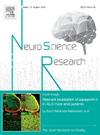直接伸臂任务中人类杏仁核的β波段功率调制。
IF 2.3
4区 医学
Q3 NEUROSCIENCES
引用次数: 0
摘要
人类的杏仁核主要因其参与处理情绪和恐惧反应而闻名,但新的证据已经确定了该结构在运动处理中的作用。我们的实验室先前使用了一个伸臂任务,并观察到海马体中显著的β波段(13-30Hz)调制。鉴于这些结果,我们试图用立体脑电图(SEEG)深度电极在参与者的杏仁核中描述运动执行过程中杏仁核中β带调制的作用。我们发现,与固定(基线)相比,13名参与者中有9名(69.2%)在手臂伸展任务的反应(运动执行)阶段杏仁核的β带功率下降。二次分析表明,在同侧和对侧植入电极之间,β波段调制没有统计学上的显著差异,但在男性和女性参与者之间存在微小差异。在直接到达任务的反应阶段,杏仁核的β波段功率下降与我们之前在海马体中的发现是一致的。我们的研究首次报道了运动加工过程中杏仁核的β带调制,并为进一步研究杏仁核参与运动控制奠定了基础。本文章由计算机程序翻译,如有差异,请以英文原文为准。
Beta-band power modulation in the human amygdala during a Direct Reach arm reaching task
The human amygdala is primarily known for its involvement in processing emotional and fearful responses, but newer evidence has identified a role for this structure in motor processing. Our lab previously utilized an arm-reaching task and observed significant beta-band (13–30 Hz) modulation in the hippocampus. Given these results, we sought to characterize the role of beta-band modulation in the amygdala during movement execution in participants with stereoelectroencephalography (SEEG) depth electrodes in the amygdala for seizure localization. We show that 9 of 13 participants (69.2 %) showed decreased beta-band power in the amygdala during the Response (movement execution) phase of an arm-reaching task when compared to Fixation (baseline). Secondary analyses show that there are no statistically significant differences in beta-band modulation between ipsilateral and contralateral implanted electrodes, but there is a small difference between male and female participants. The decrease in beta-band power in the amygdala during the Response phase of a Direct Reach task is consistent with our previous findings in the hippocampus. Our study is the first to report beta-band modulation in the amygdala during motor processing and sets the stage for further studies into the involvement of the amygdala in motor control.
求助全文
通过发布文献求助,成功后即可免费获取论文全文。
去求助
来源期刊

Neuroscience Research
医学-神经科学
CiteScore
5.60
自引率
3.40%
发文量
136
审稿时长
28 days
期刊介绍:
The international journal publishing original full-length research articles, short communications, technical notes, and reviews on all aspects of neuroscience
Neuroscience Research is an international journal for high quality articles in all branches of neuroscience, from the molecular to the behavioral levels. The journal is published in collaboration with the Japan Neuroscience Society and is open to all contributors in the world.
 求助内容:
求助内容: 应助结果提醒方式:
应助结果提醒方式:


